A cold front cleared out the warm moist air of yesterday and gave us a brisk chill wind out of the north and partly-sunny skies. So a long walk in the afternoon, producing (as usual) many interesting and beautiful things to see and think about.
First was a mockingbird’s nest in an osage orange or bois d’arc tree:
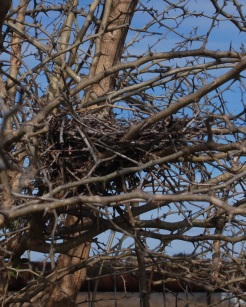 From farther out in the field, I looked back and saw an unusual cloud formation:
From farther out in the field, I looked back and saw an unusual cloud formation:
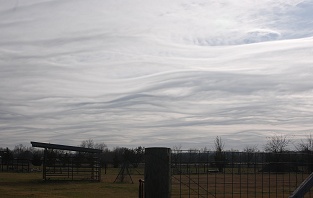
Next, hiding beneath the grass, the promise of bluebonnets next spring:
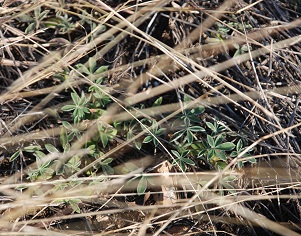
The natural course of the secondary drainage in the near meadow is now mostly grassed in, but there are several arc-shaped “pools” below the #3 gabion. One of the most beautiful, this afternoon, was a single clump of brushy bluestem with its seeds forming a plume…ready to disperse and become new colonies of this valuable native grass.
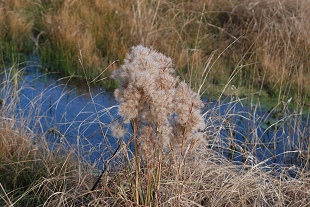
Up in the dry woods, on Cactus Flat, the cool-season forbs are spreading well in this wet fall/winter, including the Texas Cranesbill. In winter, after a sharp freeze such as we had last week, some of its leaves turn brilliant red…the slanting winter sun sets them on fire.
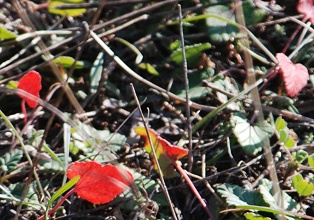
The dry woods has an upper level, with older trees and thicker woods–the soil also has a different texture. In moist winters, it can look like a very different kind of woods–cool season grasses and forbs form a lush green carpet and will burst into flower in the spring. We don’t go up in this area in summer, because of the rattlesnakes–hard to see them and hard to retreat through the tangles of elbowbush, Mexican buckeye, and leaning/fallen trees and branches. But it’s beautiful–the only drawback being the highway noise, especially an east or north wind.
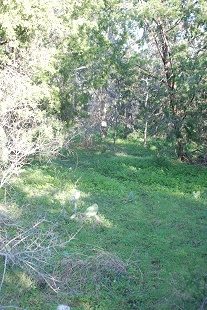
The upper dry woods has many burrows, at least some of which are fox dens. This one has been in and out of use from year to year–right now, there are signs of current use.
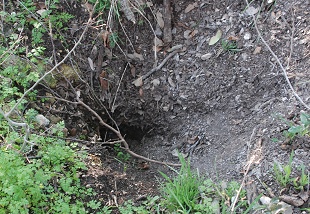
Finally…aromatic sumac doesn’t look like other sumacs, but it does have beautiful fall color and handsome red berries in summer–berries relished by birds and other wildlife. Only a few leaves remained on this particular plant, but when the sun touched them, I could not resist taking a picture.
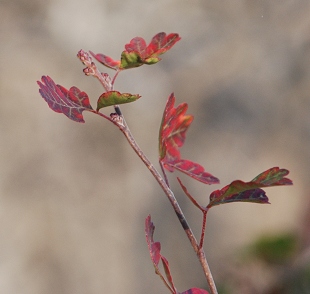
Comment by cdozo — December 15, 2009 @ 9:43 pm
Those photos are so pretty and your picture of the clouds is just amazing.
Your land is so beautiful.
Comment by elizabeth — December 15, 2009 @ 9:48 pm
Those clouds were really strange looking. I wish I’d seen them sooner–they blew away to the southeast. It looked like ribbon candy–would have looked more than way if they’d had color.
Comment by Adam baker — December 16, 2009 @ 12:18 am
Oh wow, w/ those kinds of views, I can definitely see how it helps your problems melt away.
Comment by elizabeth — December 16, 2009 @ 12:51 am
(smiling happily)
Comment by AJLR — December 16, 2009 @ 9:54 am
Beautiful pictures, thank you.
Is the Bluestem totally dependent on wind-dispersal for its seeds? They look very fluffy from your picture but I wondered whether the seeds also survived dispersal by water (as it’s growing here so near some).
Comment by elizabeth — December 16, 2009 @ 10:24 am
The seeds float on the water (thanks to all the fluff) and are blown across water surfaces, as well as windblown. My guess (and it’s only a guess) is that wind–for either airborne or surface “skating”–is the primary mode of dispersal, moving the seeds to the water margins, which is where this grass prefers to be. I need to get out there today and take a handful up above the #3 gabion. The margins there would be a perfect habitat for it.